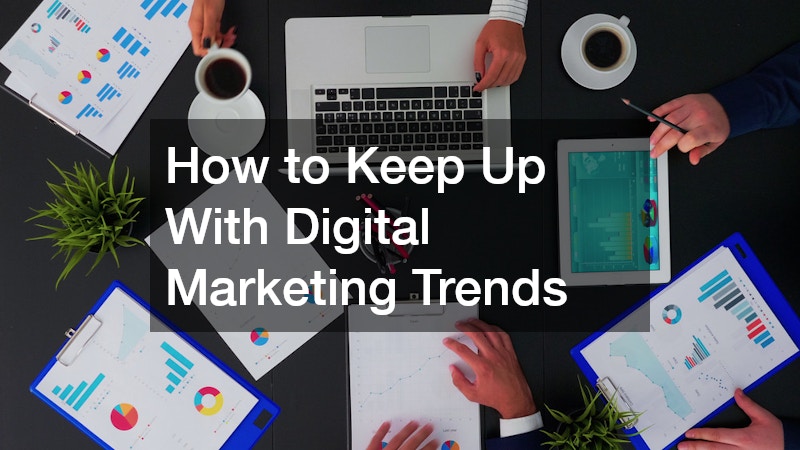

In the fast-paced world of digital marketing, staying ahead of the curve is crucial for success. With new technologies, shifting algorithms, and evolving consumer behaviors, marketers must continuously adapt to remain relevant and competitive. The digital landscape changes rapidly, what worked a year ago might be obsolete today. This article explores effective strategies for keeping up with digital marketing trends, from continuous learning to leveraging the latest tools and analytics.
How Can Businesses Stay Up-to-Date With Digital Marketing Trends?
Continuous Learning and Development
In an industry that never stands still, a commitment to ongoing education is essential. Continuous learning helps marketing professionals stay sharp, informed, and ready to innovate. Webinars are a powerful resource, offering direct access to experts discussing the latest innovations, algorithm updates, and strategies. Many are free and interactive, providing the chance to engage with thought leaders in real time. Online courses through platforms like HubSpot Academy, Coursera, and Google Digital Garage allow marketers to deepen their understanding of SEO, analytics, and paid advertising. Networking with industry leaders, whether through LinkedIn or conferences, provides opportunities to exchange ideas and discover best practices. In-house training sessions or guest lectures can align teams and encourage collaborative growth. Digital marketing forums such as GrowthHackers, Reddit’s r/marketing, and the Moz Community also offer valuable insights, where marketers share real-world experiences and emerging tactics.
Subscription to Industry Newsletters
Subscribing to trusted newsletters is one of the easiest and most effective ways to stay informed about new developments in digital marketing. Publications like MarketingProfs, Search Engine Journal, and Social Media Examiner deliver curated insights directly to marketers’ inboxes, summarizing important trends and actionable strategies. The best approach is to combine multiple sources—mixing SEO, social media, and analytics-focused newsletters—to form a well-rounded understanding of the industry. Many newsletters also highlight real-world case studies that demonstrate successful marketing tactics, offering inspiration for future campaigns. By tracking patterns and recurring themes across these publications, marketers can identify rising trends early and use that knowledge to refine their strategy planning. Newsletters also provide a quick way to monitor algorithm changes, new tools, and evolving consumer behaviors—all without spending hours researching.
Leveraging Analytics and Data
In today’s data-driven world, analytics form the backbone of effective marketing strategies. Real-time data helps businesses make quick, informed decisions based on actual performance rather than assumptions. By monitoring website traffic, social engagement, and conversion metrics, marketers can quickly identify what’s working and what needs adjustment. Understanding customer behaviors—such as which pages they visit most or where they drop off—enables more personalized and effective messaging. Predictive analytics take this a step further by forecasting trends based on past behaviors, helping marketers anticipate customer needs and tailor their campaigns accordingly. Data visualization tools like Google Data Studio and Tableau make it easy to turn complex metrics into clear, visual insights that teams can understand and act on. In essence, leveraging analytics allows businesses to stay agile, make smarter decisions, and remain competitive in a rapidly changing market.
Engaging with Online Communities
Participating in online communities is a valuable way to stay connected with others in the marketing industry. Professional networks like LinkedIn and Slack channels focused on marketing topics allow individuals to share ideas, seek advice, and collaborate on new initiatives. Joining specialized marketing forums such as Inbound.org or the Content Marketing Institute’s network provides exposure to targeted discussions and expert insights. Active participation in these communities not only builds credibility but also opens the door to mentorship and collaboration. Peer reviews and community feedback offer fresh perspectives, helping marketers refine their approaches and learn from others’ experiences. Collaborative tools like Notion, Trello, and Asana further enhance teamwork and information sharing, making it easier for marketing teams to work together effectively, even in remote environments.
Experimentation and Testing
Experimentation is key to staying innovative in digital marketing. A/B testing allows marketers to compare different versions of ads, landing pages, or email campaigns to see which performs better, leading to data-backed improvements. Developing iterative marketing strategies—where campaigns are tested, analyzed, and adjusted over time—helps maintain flexibility and relevance. Feedback loops ensure that audience reactions are considered in every step of the testing process, resulting in more meaningful and user-focused refinements. Cost-effective tools like Google Optimize and Meta’s Ad Experiments make experimentation accessible for businesses of all sizes. Once successful tests are identified, scaling them across other platforms can amplify results and improve overall ROI. Embracing a culture of experimentation keeps brands at the forefront of innovation and ensures continuous growth.
What Tools Are Essential for Tracking Digital Marketing Performance?
Google Analytics and Tag Manager
Google Analytics remains one of the most important tools for understanding website performance and user behavior. Properly setting it up allows businesses to track traffic sources, engagement metrics, and conversion data with precision. Google Tag Manager complements this by simplifying the process of adding and managing tracking codes without altering the website’s code directly. Custom reports within Google Analytics can be tailored to highlight specific KPIs, helping marketers focus on what matters most. Integrating Google Analytics with CRM or social media tools creates a unified view of marketing performance, while analyzing user flow and engagement provides actionable insights into how visitors navigate and interact with content.
Social Media Analytics Tools
Social media analytics tools help marketers track engagement and uncover trends across various platforms. Hootsuite and Buffer make it easy to schedule posts, monitor performance, and manage multiple social accounts in one place. Sprout Social offers deeper analytics and reporting, providing insights into engagement patterns, audience demographics, and content performance. Tracking likes, comments, shares, and follower growth allows marketers to measure the effectiveness of their content and identify what resonates most with audiences. Social insights also help uncover trending topics, while competitor analysis through these tools highlights opportunities to refine strategy and stand out in the digital space.
Email Marketing Tools
Email marketing remains a cornerstone of digital communication, and tools like Mailchimp and Constant Contact streamline the process from start to finish. These platforms enable marketers to design campaigns, automate scheduling, and segment audiences for more personalized outreach. Segmenting email lists based on behavior, demographics, or purchase history increases engagement and relevance. Automation features ensure consistent communication without requiring constant manual input. Tracking email performance through metrics like open rates, click-through rates, and conversions provides clear insight into campaign success. By refining these strategies and focusing on targeted, data-driven communication, businesses can significantly improve ROI and customer retention.
SEO and SEM Tools
SEO and SEM tools are essential for understanding and improving search visibility. SEMrush helps marketers optimize content, conduct keyword tracking, and perform site audits to enhance rankings. Ahrefs excels in keyword research and backlink analysis, identifying valuable opportunities to boost organic reach. Tracking organic search performance allows businesses to measure progress and refine their strategies for better results. Tools for managing pay-per-click campaigns, such as Google Ads, enable precise tracking of ad spend and conversion data. Competitor SEO analysis further helps identify content gaps and strategies that can be leveraged for growth. Together, these tools form a complete ecosystem for managing both organic and paid search marketing.
Customer Relationship Management (CRM) Software
CRM systems like Salesforce are indispensable for managing customer relationships and optimizing marketing efforts. They allow businesses to customize customer journeys, providing personalized experiences based on behavior and preferences. CRMs store valuable data from every customer interaction, offering insights into engagement, satisfaction, and loyalty. Automation features streamline follow-ups and nurture campaigns, increasing efficiency while maintaining a personal touch. CRMs also help measure customer satisfaction and retention rates, ensuring long-term growth. When integrated with marketing and sales tools, CRM platforms create a seamless connection between departments, enabling unified strategies and more effective customer engagement.
Conclusion
Keeping up with digital marketing trends requires a proactive mindset and a willingness to evolve. By investing in continuous learning, leveraging analytics, engaging with professional communities, experimenting strategically, and utilizing powerful tools, marketers can stay ahead in a rapidly changing environment. The key is to remain adaptable—embracing innovation while maintaining a clear focus on business objectives. Those who consistently learn, analyze, and refine their strategies will not only keep up with digital marketing trends but also help define them.



